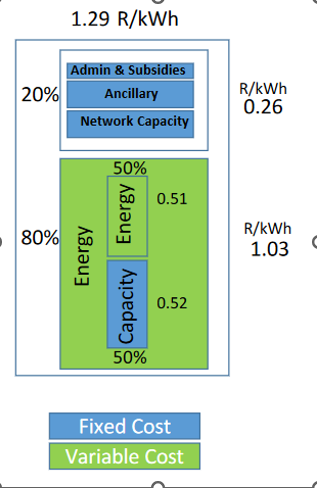In my presentation to the South African Portfolio Committee on Mineral Resources and Energy, I emphasized once again the imperative for the National Energy Regulator of South Africa to transition towards treating electricity as a service.
I argued for the implementation of a capacity charge, denominated in rands per amp, to ensure that customers bear The Full Cost of Electricity. This approach aims to prevent those with solar panels on their roofs from shifting service costs, including peak capacity, dispatched ramping, synchronous power, system strength, frequency, and voltage stability, onto less affluent households.
Moreover, I argued against the regulator actively "setting prices" and advocated for a role more aligned with the "monitoring of prices," drawing parallels with the telecommunications industry's approach. This change in perspective aims to prevent the regulator from inadvertently causing shortages (i.e. load shedding) while still ensuring fairness, accountability, and the reliability of the electricity system. Additionally the regulator will still have the responsibility to eliminate uncompetitive behavior from a natural monopoly.
After noting this, a few subscribers have requested a more detailed explanation of how electricity as a service would function in practice.
Drawing a Lesson from the Telecommunications Industry:
My career began with a six-month stint in the telecommunications sector, where I worked on tenders for a company constructing cellphone towers across South Africa. When these towers were struck by lightning there was always a rush for emergency fuel. Companies were willing to invest significant sums in diesel generators to restore tower functionality promptly. The urgency stemmed from the understanding that any signal loss for more than a few hours could lead customers to switch to competitors.
In the industry's early days, there was a misunderstanding that customers were enticed solely by promotions like "free calls on weekends," "bundled SMS," or "another 3GB of data." These promotions gradually faded as the industry realized that customers valued a consistently available connection. Consumers were willing to pay a fixed fee for that connection, even if they didn't fully utilize the network.
The cost to maintain this connection isn't primarily determined by usage during routine operation, but rather by what transpires during emergencies. Whether a diesel generator (or battery) is needed on standby every 1, 10, or 1000 years depends on the business case, and customers are priced accordingly through fixed prices.
During that time, our CEO told me that solving the "affordable battery storage problem" would lead to my early retirement by the age of 30. Now, at 33, I haven't achieved that goal, and I'm unaware of any engineer retiring for that reason.
As mentioned previously, one of the major misconceptions about electricity is viewing it as a commodity rather than a service. Similar to cellphone contracts, consumers are more concerned about the service's availability than the amount of kilowatt-hours consumed. Eskom is, in fact, selling South Africans a service (albeit a problematic one), but the pricing model treats it as a commodity, and it's high time for a paradigm shift.
The figure below, obtained from a reliable source at Eskom, illustrates how the electricity tariff is broken down. Much like scrutinizing the petrol price, South Africans should insist on a clear breakdown of the electricity price, including the amount allocated to taxes!
At a rate of R1.29 per kWh:
51 cents per kWh is allocated for the consumed electricity.
75 cents per kWh is designated for services ensuring a stable 60 amps connection.
A quick google search indicates that the average urban home in South Africa consumes 3500 kWh per year, forming the basis for my calculations.
In a service model, the average household should be billed as follows:
R0.51/kWh x 3500 kWh = R1 785 per year for consumed electricity.
R0.75/kwh x 3500 kwh = R2 625 per year as a fixed charge for the 60-amp connection.
An "Electricity as a Service" promotion would would read as follows.
Electricity only R220 per month at only 51 cents per kWh for the first 3500kWh!
Even for those utilizing solar panels, a capacity charge of R2 625 per year or R220 per month should remain applicable.
Fully off-grid customers, (that don’t use Eskom as a backup battery with free insurance), should be the only ones capable of sidestepping the full cost of electricity.
For individuals with needs such as holiday home goers, an alternative price akin to a "pay-as-you-go option" for cell phones should be introduced. They should Pay R5 per kWh (equivalent to the price of diesel for emergency fuel).
Farmers and industrial users already pay a capacity charge, so it's not really new to them, so do many residential households, who already pay the municipalities for a service.
I anticipate that, akin to cellphone contracts, over time, the kWh value will diminish, and electricity trading in kWhs may eventually fade away.
Similar to the early phases of the internet, those who envisioned an "unlimited connection" served by only a fixed price could become a reality. Electricity as in the words of Lewis Strauss, the former chairman of the United States Atomic Energy Commission, under a service model, would become “too cheap to meter”




